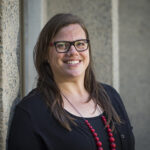Episode Notes
Who do you picture when you think of the word “poor”? In a prosperous nation like Australia, surely no one should be living in poverty—but we all know that plenty of people from all walks of life don’t have enough to make ends meet. In this episode of Seriously Social, economist and Deputy Director of the HILDA Survey, Professor Roger Wilkins crunches the numbers on what poverty in Australia looks like and what we can do about it, and demographer Dr Liz Allen breaks down why “pulling yourself up by your bootstraps” isn’t as simple as it sounds for those who find themselves in dire financial straits.
Transcript
Professor Roger Wilkins (00:02):
No one plans to be poor.
Ginger Gorman (host) (00:04):
Professor Roger Wilkins has made a close study of poverty and how it works in Australia.
Professor Roger Wilkins (00:10):
That should be your starting point as a policymaker. And I think well then, if no one wants to be poor, how can we help them to make decisions and to achieve their capabilities to live a good life?
Ginger Gorman (host) (00:23):
Being poor in Australia is not what you might expect.
Professor Roger Wilkins (00:27):
As a modern developed country, we tend to conceive of poverty as what we call a relative concept. You are unable to participate in the normal activities of life that are considered normal for that society.
Ginger Gorman (host) (00:42):
It can be hidden over a lifetime of falling behind, missing out, trying to catch a break.
Dr Liz Allen (00:49):
I was born into a large family and experienced quite significant disruption including institutional child sexual abuse.
Ginger Gorman (host) (01:03):
Dr. Liz Allen is a demographer and she’s pretty well known within Australia’s academic world for her expertise in population health and social inequality. But she doesn’t only know the facts and figures, she knows poverty, and that’s because she’s lived it.
Dr Liz Allen (01:18):
So my life became very derailed by the time I was 11.
Ginger Gorman (host) (01:24):
By the time Liz was 13, her life was off track.
Dr Liz Allen (01:28):
Life was just unbearable, and it was that point that I was put into an institution. From then on, I jumped around out of home care, not in foster care, in institutional settings. And then by the age of 16, I was homeless and confronted with pretty dire poverty. I longed to belong somewhere. And so I had my eldest child at 17, and it was the birth of my child that made me realise that I would have to get my life together somehow. I owed it to her.
Ginger Gorman (host) (02:06):
In case you’re thinking that this is one of those anecdotes where someone living in abject poverty pulled herself up by the bootstraps and made something of herself, it’s not.
Dr Liz Allen (02:16):
It’s hard to describe, like having no place to go, having no family and nothing to fall back on. You literally have absolutely nothing. And the decision-making processes and what requires this kind of notion of survival is totally different. When you experience this kind of trauma, it embeds itself within your genetics. The stress changes you, the scarcity changes you, the unknowing changes not only your kind of blood chemistry, but also your brain.
Ginger Gorman (host) (02:58):
This is Seriously Social. I’m Ginger Gorman on Ngunnawal country. About 35 years ago, Bob Hawke made this famously failed promise.
Bob Hawke (03:08):
By 1990, no Australian child will be living in poverty.
Ginger Gorman (host) (03:15):
So how do we define poverty? What drives people into it? And can we end it once and for all? Professor Roger Wilkins is a fellow of the Academy of the Social Sciences in Australia. He heads up the HILDA Survey for Melbourne’s Institute of Applied Economic and Social Research. HILDA stands for Household, Income and Labour Dynamics in Australia. It’s a longitudinal study of Australian households. Let’s start with the basics: Poverty 101.
Professor Roger Wilkins (04:00):
When we think of poverty in developing countries, we are thinking there of an inability to adequately sustain life, that they literally don’t have enough money to meet their nutritional needs and their shelter needs. But in a developed country, we think of it more as something relative to the accepted standard of living in that community.
Ginger Gorman (host) (04:21):
In other words, as a developed country, Australians living in poverty aren’t experiencing the same levels of famine and displacement as the people in say, the Horn of Africa, but they can’t access what they need to survive in this economy.
Professor Roger Wilkins (04:37):
We do have people who are going hungry, but that sort of acute poverty is not that common in our community. And certainly most studies, surveys, for example, don’t reveal much of that kind of absolute deprivation. But what we do see is people who are unable to afford a smartphone. And increasingly it is just an expectation that people will have a smartphone. Even when you’re trying to access government services and so forth, it’s often just presumed you will have a smartphone.
Ginger Gorman (host) (05:10):
Roger says poverty isn’t about having a lack of money. It’s a lack of resources that allow you to access enough money.
Professor Roger Wilkins (05:18):
Resources don’t just include your income. They also include any assets you might have. You might own a home, but it’s also things like being in good health is a resource. If you are in poor health, that limits your ability to live a good life. It’s also about having time. While we all have 24 hours in a day and seven days in a week and so forth, if we have lots of competing demands on our time, that might also reduce our ability to achieve an acceptable living standard. So if, for example, you are a single parent who has caring responsibilities for young children and you are also working, then you have very little time left over for growing your own seeds or doing other sorts of home production that could improve your living standards.
Ginger Gorman (host) (06:06):
How do we measure poverty with things like the Henderson poverty line or even the HILDA survey that you’ve been so deeply involved with for so many years?
Professor Roger Wilkins (06:18):
Internationally, the convention for OECD countries at least, is to approximate poverty as occurring when your household income is less than half the median household income. Now, that’s an income that’s adjusted for household size because obviously bigger households need more income to, for example, feed all of the people in that household. But after you make those adjustments, if your income is less than half of the median, so less than half the middle income, then you are deemed to be in poverty. As I said, it’s not a perfect measure. You’ll find people with low incomes who are doing fine, particularly if they, for example, own their own home outright. And you will see people with incomes above that threshold who really do need more income to achieve what we would generally regard as an acceptable living standard.
Ginger Gorman (host) (07:16):
How do you measure poverty with the HILDA survey because it’s quite different from that, it’s more nuanced than that?
Professor Roger Wilkins (07:23):
In the HILDA survey, the measure of poverty we use is based on that half median income concept. The Melbourne Institute where I work, we have also been producing another poverty measure called the Henderson Poverty Line, which has its origins back in the early 1970s. And this was originally set at the level of the basic wage plus a government payment called Child Endowment for a family of four. And the argument was that this was an income so low that no one would argue that a family living on that income wasn’t poor. Since then, it’s then been updated in line with growth in average incomes in the community so that the Henderson poverty line today is actually somewhat above the 50% of median poverty line.
Ginger Gorman (host) (08:16):
HILDA has been tracking poverty since 2001. So what do the most recent results tell us about how Australians are faring?
Professor Roger Wilkins (08:26):
The overriding impression is that we’re standing still, we’re running on the spot. We’re not making progress and we’re not going backwards. The level of poverty as measured in the HILDA survey has been tracking at around about 12% for almost all of the, well now, 21 years that HILDA has been running, which can create the impression that it’s an intractable problem, that we just can’t do anything about it. It’s just going to stay at around that 12% level no matter what we do. And that would be a very wrong conclusion to make. And if you wanted some evidence for that, it would be to look at what happened in 2020 when, in response to the COVID pandemic, the federal government and the states as well introduced a range of income supports.
(09:12):
And what we saw when those payments were introduced was a sharp fall in the number of people in poverty, and associated with that, it wasn’t just that we saw this measure of poverty decline almost mechanically by increasing their incomes. There’s a number of other measures in the HILDA survey that measure people’s financial wellbeing, their experience of financial stress, their satisfaction with their financial situation, and on all those measures, you saw a very dramatic improvement. And so it really, I think, drove home the point that it is within governments’ power to move the dial when it comes to poverty.
Ginger Gorman (host) (09:52):
But Roger isn’t suggesting eliminating poverty is an easy fix.
Professor Roger Wilkins (09:56):
The size of the program in 2020 was not fiscally sustainable, but it did show that if we made an effort, there’s definite scope for improving the wellbeing of low income people.
Ginger Gorman (host) (10:09):
The other thing we learned from HILDA is that for most people who experience poverty, it’s temporary.
Professor Roger Wilkins (10:15):
They have adverse events, they lose a job, they have an illness that makes it hard for them to work, but then they bounce back. And so for those, I guess, you’d say there’s less of a concern, it’s still a concern that they go through that hardship period, but at least they manage to pull themselves out of that situation. But there is a significant pool of people in the Australian community who are in long-term poverty, and HILDA is able to show us that because it’s a longitudinal study that interviews the same people every year. And we see probably around 4% to 5% of the population is in long-term poverty. And that’s certainly a group that we could definitely do more about improving their wellbeing.
Dr Liz Allen (10:54):
I think what many Australians consider the ordinary social side of life is pretty exclusive, and it is off limits to people who experience or perhaps who have once experienced poverty. Because I think the other kind of lie we like to tell ourselves in Australia is that it is the home of the fair go and that if you have a go, you’ll get a go. That’s absolutely not the case. And while Australia might be better placed in terms of inequality and people overcoming disadvantage, there is still very little social mobility in Australia. So the circumstances you might be born into or you find yourself fall into, outside of your control, are very difficult to get out of. Once you are in a low socioeconomic circumstance, it’s hard to get out. I’ll give you an example. When I was 16, I thought, “I’ll get a job, I’ll get a job and I’ll get out of this.
(12:02):
I’ll get out this place”. So, the situation, I was homeless, I couldn’t shower. I couldn’t afford to buy clothing for the interview, and I couldn’t afford, if I got the job, to have clothing to then be at the job and front up to work and so on. So there were these kind of insurmountable barriers to get this job. And even once, if you do get this job or a job, some job, the wage is so low for the types of jobs that I could get at 16. I’m talking an egg collector in a farm, but I couldn’t get there because I didn’t have a car. I was too young, I didn’t have a license. I couldn’t even afford a license. So that was off limits to me. The other one was I could work doing nail painting, fingernails and things like that, and I got really sick because of my asthma.
(13:04):
And so there was nothing I could really do that could break me out of my situation. My health was very poor as well, and I couldn’t afford healthcare. I think people realise just basic medicines, and as I said, I couldn’t even shower, I couldn’t bathe. So all of the decisions you have on offer are very constrained. Whereas someone might say, I don’t know, a politician might say that the barrier to a successful life or to owning one’s home is a good job. When you’re poor, you don’t think about that. You think about how am I going to survive? How am I going to eat? How am I going to drink? And that was the other thing.
(13:50):
I still remember the thirst, being physically thirsty, because I didn’t have access to clean drinking water and I didn’t have money to buy a bottle to keep water in it. And when I became homeless, it was around the time when water preservation in Western Sydney became a really big deal. And so the councils went around and put these knobs on taps so that no one could access the taps without the special key knob. So there was nothing, we kind of overnight had nothing. And there are these kind of small things that I think people take for granted, that when you are living in poverty, it is your everything. It is your world.
Ginger Gorman (host) (14:43):
Professor Roger Wilkins says the face of poverty has changed. A couple of decades ago, it was dominated by older people, people living with disability and people living with poor physical or mental health.
Professor Roger Wilkins (14:55):
It’s still the case that those groups have relatively high poverty rates, but what we’ve also seen is a significant rise in the proportion of people in poverty who are of working age and are often actually even working poor because they can’t get enough hours of work to obtain an adequate income and a particular demographic group that’s really, I think, doing it increasingly tough are single parents, particularly single parents with young children. The policy environment has become more hostile to them in terms of the level of payments and the requirements to work or look for work, and on a variety of metrics, not just on their poverty rates, but on things like their mental state, their measures of financial stress, time stress, quality of their relationships, on all these dimensions, we’ve seen a marked decline in the wellbeing of single parents and policy settings are strongly implicated in that.
Ginger Gorman (host) (15:56):
While Gen Xers like me scrimped our way through our early 20s by eating microwave noodles, living in dilapidated share houses and relying on Austudy or the dole, a lot of us made it through and have gone on to build careers and own at least one home. But Gen Zs face challenges that the generations before them didn’t have to confront.
Professor Roger Wilkins (16:19):
The transition to adulthood has become more difficult over the last 20 odd years. And by that what I mean is that, it’s increasingly necessary to have significant educational qualifications in order to get a foothold in the labour market. And even when you have university level qualifications, it’s still taking longer for graduates on average to get into full-time career type jobs. They’re also moving out of their parental home later. Housing costs are obviously an important driver of that. They’re marrying later, they’re having children later. And if you go to university, then you leave with a significant Higher Education Loan Program debt or traditionally known as a HECS debt. And so we are seeing that it’s taking young people longer to establish themselves economically and be in a position to do the things we traditionally associate with the move into adulthood.
(17:19):
It becomes almost a self-fulfilling prophecy that they will be poor, because in a way, they are being set up to fail. That if they are poor, they then don’t have the capacity to invest in their own human capital, for example, through education; that they then are not in a position to be what you might call job-ready and then get into work and then get on that trajectory towards economic independence. And it’s a real false economy to be putting young people on very low benefits and making it very difficult to get on benefits because you end up perpetuating into the future greater reliance on that welfare system.
Ginger Gorman (host) (17:57):
So how do we solve this problem? How do we support people dealing with temporary but really tough times and how do we bring that steady figure of 12% down to zero?
Professor Roger Wilkins (18:11):
Jobs are still the number one way of people getting out of poverty. And any government that takes its eye off that goal of maximising employment in our society is negligent because that is the most important way in which we improve people’s living standards and help them. That said, it’s not the only solution, and there are plenty of people for whom we see this in the HILDA data where employment is not really a viable option, at least employment that will be adequate to give them a sufficient income. And if your only anti-poverty policy is to get people into work, these are people that are going to get left behind and end up in poverty. And so yeah, we do need to adequately invest in our income support system to ensure that these people can have an adequate living standard without being adequately employed.
Ginger Gorman (host) (19:08):
You said poverty isn’t intractable, and you went into some detail there about some of the levers that were pulled at the beginning of the pandemic, but can you talk more broadly about the kind of levers that we have available to us when it comes to solving this 12% of people who are in poverty?
Professor Roger Wilkins (19:29):
Well, the most obvious lever is to boost the adequacy of income support payments. Now, the concern that gets raised there is, one, that it’s costly to the budget, and two, that it reduces the incentives for people to look for work, but the available evidence is that those adverse incentive effects can be managed and are really probably over-emphasised by those who raise that concern. In terms of the cost to the budget, it’s something that’s given, I think, too much emphasis. There are plenty of other savings available for the Federal Government that would enable additional investment in the income support system without raising taxes. The obvious one that gets raised at the moment is the so-called stage-three tax cuts that are due to come into effect in 2024.
(20:26):
I think that if you didn’t proceed with those, that would improve the capacity of government to provide for those who have low resources. Having mentioned the importance of the income support system, it’s not the only option available to government. There’s a lot that could be done in housing to improve housing affordability and investments in social housing. We have seen some positive moves in that regard, but certainly more could be done there and then there’s simply just investing more in our education system as well to improve the lifetime prospects of particularly children in all families.
Ginger Gorman (host) (21:05):
How do you see it being linked to the idea of prosperity for the nation?
Professor Roger Wilkins (21:09):
Well, what good is prosperity if it’s not for all of us? It just seems self-evident to me that if you are concerned with the prosperity of the nation, then you are concerned with the prosperity of all members of that community that make up that nation. The idea that we could be a prosperous nation if we essentially had one super-rich individual and everyone else was struggling, and yet because that super-rich individual was just so rich, our average income looked high. No reasonable person would say we were a prosperous nation even if we had a high GDP per capita. But that extreme example helps clarify, I think, that point that how the fruits of the economy are distributed really matters, and in particular, how much is received by those receiving the least is a key metric for any society.
Dr Liz Allen (22:04):
The voice of those who experience poverty doesn’t carry the weight of an ordinary person. People who experience poverty are seen often in our social narrative, if you like, as less than or undeserving odds. The reality is that in contemporary Australia, we have young people particularly who are working more than 1, 2, 3 jobs and not surviving. They are poor. They are having a go. The problem is that we have social structures and social policy that does not support people who are born into or who fall into poverty. We don’t have a fair go and we don’t have a place where equity is an option. We’ve got to a point now where it’s easier to look away and consider perhaps what the middle class is missing rather than what the poor and the hardest working individuals are experiencing. We know what works in terms of policy. We proved what works during the early days of COVID to help lift people, particularly young people and children, out of poverty. We don’t have the political will to solve these problems.
Ginger Gorman (host) (23:51):
Thanks for listening to Seriously Social, I’m Ginger Gorman. This podcast is produced on Ngunnawal, Yuggera, and Turrbul land, and we pay our respects to Elders past and present. Seriously Social is produced by Kim Lester, engineered by Mark Gargeldonk, AKA Baldy, and our executive producers are Bonnie Johnson and Clare McHugh. It’s an initiative of the Academy of the Social Sciences in Australia. Next time on Seriously Social, if you are not happy with the laws of your nation, why not secede and start your very own micronation? See you then.
Useful Links
- HILDA Survey Melbourne Institute: Applied Economic and Social Research
- Henderson Poverty Line Melbourne Institute: Applied Economic and Social Research
- Child Endowment (1941-1976) Find & Connect: History & Information about Australian orphanages, children’s Homes and other institutions





